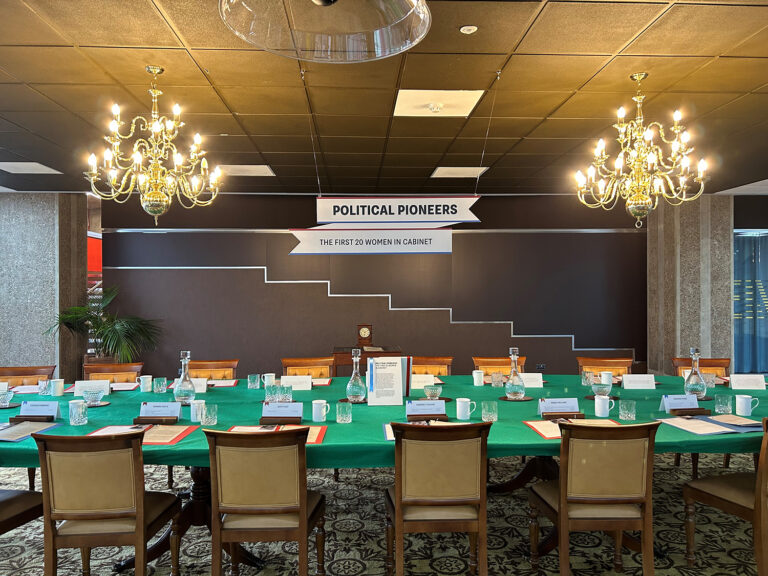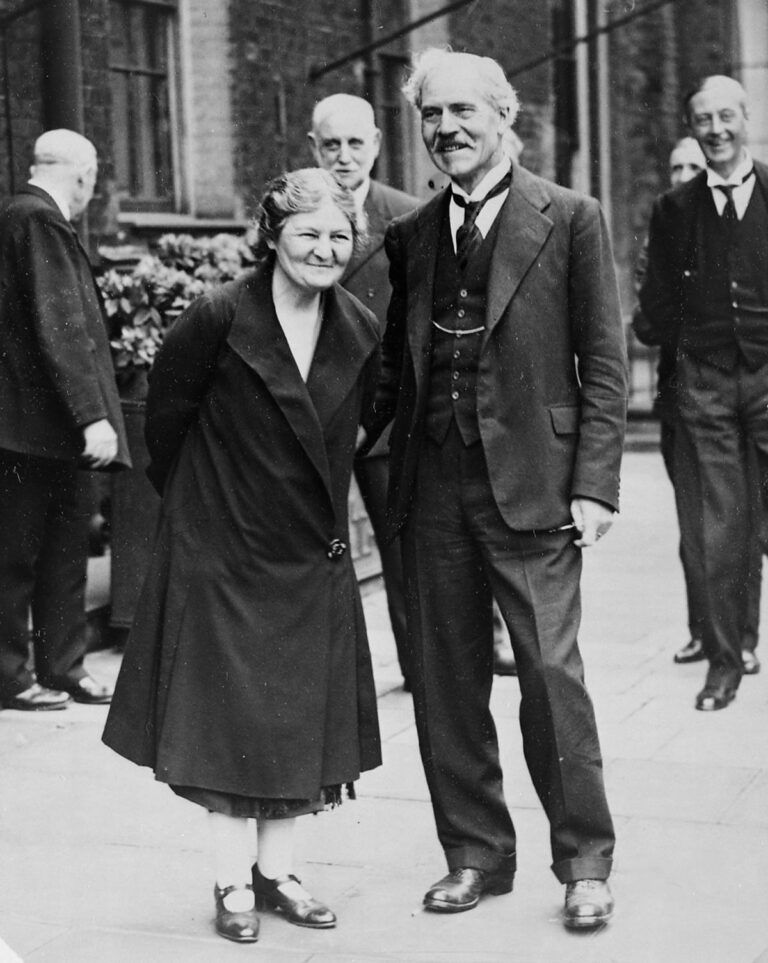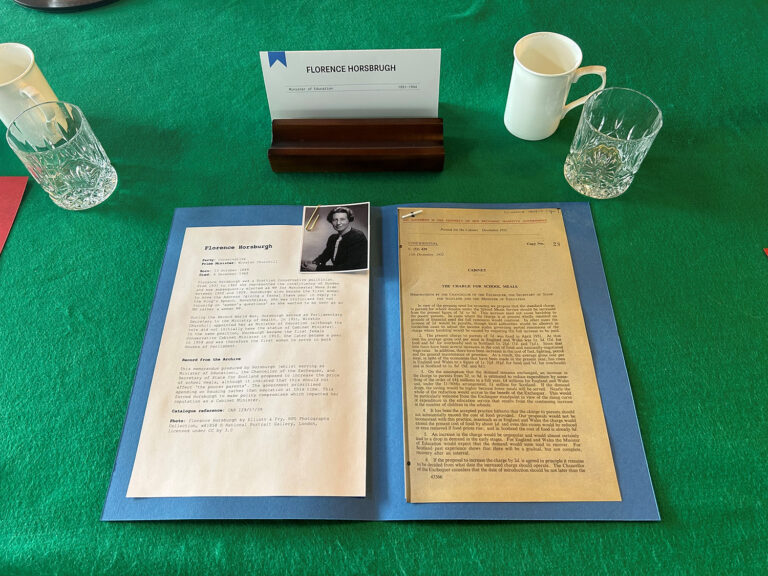Inspired by Women’s History Month, The National Archives has launched a new display on its replica Cabinet table at Kew. The display, ‘Political pioneers: The first 20 women in Cabinet’, features records on the first 20 female Cabinet ministers, from Margaret Bondfield, the first woman appointed to the Cabinet in 1929, to Patricia Hewitt who entered the Cabinet in 2001. See a list of the first 20 female Cabinet ministers at the end of this blog.

This blog post expands on some of the themes discussed in the display, such as women’s journeys into Parliament and government, the various challenges they experienced, and the types of Cabinet positions women have often been appointed to.
Barriers to entering Parliament and government
Women are underrepresented in positions of power, particularly in Parliament and government. Indeed, women were not able to stand for Parliament until November 1918, following the passing of the Parliament (Qualification of Women) Act. At just 27 words long, this act enabled women over the age of 21 to contest parliamentary elections for the first time.

And yet, women experienced numerous challenges, such as difficulties in getting selected as candidates, lack of election funds, sexism from voters and the local constituency party, and male candidates being prioritised for ‘safe’ seats.
For instance, Margaret Bondfield was selected for the constituency of Northampton, a seat deemed as unwinnable for Labour. The constituency had long been held by the Liberal Party and Bondfield was the first Labour candidate to contest Northampton. She stood unsuccessfully in the 1920 By-Election and 1922 General Election, before being elected in the 1923 General Election. However, Northampton was not an easy seat for a Labour candidate to win, and Bondfield subsequently lost her seat there in the 1924 General Election (although she later returned to Parliament in 1926 as MP for Wallsend). Bondfield was appointed as Minister of Labour in 1929, becoming Britain’s first woman Cabinet minister.

Once elected to Parliament, it was not easy for women to climb the political ladder, and only a small number of women have risen to Cabinet positions. The barriers to reaching government were, and still are, exacerbated by other factors, such as ethnicity, disability, sexuality and class background, which in turn have impacted the women who have held Cabinet roles. The fact it has taken from 1929 to 2001 for 20 women to enter the Cabinet highlights these barriers further.
In her autobiography, A Woman’s Work, Harriet Harman discusses the challenges associated with entering the Cabinet for the first time. After Labour’s election victory in 1997, Harman was appointed as Secretary of State for Social Security and Minister for Women and Equality in Tony Blair’s government. She wrote that ‘I was an experienced constituency MP and had been on the front bench for thirteen years…But the fact remained that I was wholly unprepared for being a Cabinet minister’ (see footnote 1). Harman goes on to say that her male colleagues, such as Gordon Brown and Jack Straw, ‘seemed to move effortlessly from Opposition to government’, but that she found this adjustment challenging as it required a new way of working (see footnote 2).
Gendered roles?
Initially, the types of Cabinet appointments offered to women were largely within supposedly traditional female realms. Clement Attlee, who served as Labour Prime Minister from 1945 to 1950 and 1950 to 1951 recalled that, ‘if you can, you should have some women in [the Cabinet] and there are certain jobs like Education or National Insurance where a woman will fit better than others’ (see footnote 3). This speaks to the idea that during this period, there was an expectation that women politicians should focus on issues related to the home, welfare, and social reform.
Interestingly, six of the 20 women who feature in the display held Cabinet roles related to education. For instance, Florence Horsburgh was appointed as Minister of Education and became the first female Conservative Cabinet minister. (She was appointed in 1951, although the role did not initially have the status of Cabinet minister until 1953.)

There were certain roles which were perceived to better suited to men, such as Foreign Secretary, Home Secretary, and Chancellor of the Exchequer. However, this is beginning to change. Margaret Beckett first entered the Cabinet in 1997 under Tony Blair and went on to become the first woman appointed as Foreign Secretary in 2006 (see footnote 4).
Female solidarity
Given the small number of women who have held Cabinet roles, this could sometimes foster a degree of solidarity between female Cabinet ministers. The Conservatives Gillian Shephard and Virginia Bottomley were appointed to John Major’s Cabinet in 1992. Both aware that the press were ‘looking for an excuse to write about Cabinet cat-fights’, Shephard and Bottomley agreed to not criticise each other. Shepard recalled that ‘We couldn’t possibly have been more different…[but] we said that we would never ever give anybody the chance to say that we were criticising the other. We would be supportive; end of. And we were’ (see footnote 5).
‘Political pioneers: The first 20 women in Cabinet’ provides a fascinating insight into women’s experiences in the Cabinet, the impact these pioneering women had on politics, and the changing political landscape of the country. We encourage visitors to take a seat at the Cabinet table and flick through the facsimile records for themselves to understand who these women were/are. The display runs until the end of May 2023.
Who were the first 20 female Cabinet ministers?
| Minister | Years of service |
| Margaret Bondfield | 1929–1931 |
| Ellen Wilkinson | 1945–1947 |
| Florence Horsbrugh | 1953–1954 |
| Barbara Castle | 1964–1970 & 1974–1976 |
| Judith Hart | 1968–1969 |
| Margaret Thatcher | 1970–1974 & 1979–1990 |
| Shirley Williams | 1974–1979 |
| Baroness Young | 1981–1983 |
| Gillian Shephard | 1992–1997 |
| Virginia Bottomley | 1992–1997 |
| Ann Taylor | 1997–1998 |
| Harriet Harman | 1997–1998 & 2007–2010 |
| Mo Mowlam | 1997–2001 |
| Clare Short | 1997–2003 |
| Margaret Beckett | 1997–2007 |
| Baroness Jay of Paddington | 1998–2001 |
| Helen Liddell | 2001–2003 |
| Estelle Morris | 2001–2002 |
| Hilary Armstrong | 2001–2007 |
| Patricia Hewitt | 2001–2007 |
Source: House of Commons Library Report on Women in Politics and Public Life, https://commonslibrary.parliament.uk/research-briefings/sn01250/ (accessed 9 January 2023)
Footnotes
- Harriet Harman, A Woman’s Work (London, 2017), p. 195-196.
- Harriet Harman, A Woman’s Work (London, 2017), p. 196.
- Francis Williams and Clement Attlee, A Prime Minister Remembers: The War and Post-War
Memoirs of the Right Hon. Earl Atlee (London, 1961), pp. 80-81 - Jacqui Smith was the first woman to hold the position of Home Secretary from 2007 to 2009 (although she does not feature in the display). There is also yet to be a woman appointed to the role of Chancellor of the Exchequer.
- Rachel Reeves, Women of Westminster: The MPs who changed Politics (London, 2019), p. 160.